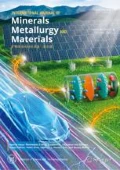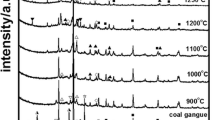Abstract
HyperCoal was prepared from low-rank coal via high-temperature solvent extraction with N-methylpyrrolidone as an extraction solvent and a liquid-to-solid ratio of 50 mL/g in a high-temperature and high-pressure reactor. When HyperCoal was used as a binder and pulverized coal was used as the raw material, the compressive strength of the hot-pressed briquettes (each with a diameter of 20 mm and mass of 5 g) under different conditions was studied using a hot-pressing mold and a high-temperature furnace. The compressive strength of the hot-pressed briquettes was substantially improved and reached 436 N when the holding time period was 15 min, the hot-pressing temperature was 673 K, and the HyperCoal content, was 15wt%. Changes in the carbonaceous structure, as reflected by the intensity ratio between the Raman G- and D-bands (IG/ID), strongly affected the compressive strength of hot-pressed briquettes prepared at different hot-pressing temperatures. Compared with cold-pressed briquettes, hot-pressed briquettes have many advantages, including high compressive strength, low ash content, high moisture resistance, and good thermal stability; thus, we expect that hot-pressed briquettes will have broad application prospects.
Similar content being viewed by others
References
C. Xu, G. Xu, S.F. Zhao, L.Y. Zhou, Y.P. Yang, and D.K. Zhang, An improved configuration of lignite pre-drying using a supplementary steam cycle in a lignite fired supercritical power plant, Appl. Energy, 160(2015), p. 882.
W.C. Xia, G.Y. Xie, and Y.L. Peng, Recent advances in beneficiation for low rank coals, Powder Technol., 277(2015), p. 206.
H. Katalambula and R. Gupta, Low-grade coals: A review of some prospective upgrading technologies, Energy Fuels, 23(2009), No. 7, p. 3392.
F.J. Liu, X.Y. Wei, M.H. Fan, and Z.M. Zong, Separation and structural characterization of the value-added chemicals from mild degradation of lignites: A review, Appl. Energy, 170(2016), p. 415.
I.S. Gwak, Y.R. Gwak, Y.B. Kim, and S.H. Lee, Drying characteristics of low rank coals in a pressurized flash drying system, J. Ind. Eng. Chem., 57(2018), p. 154.
X. Li, Z. Zhang, L. Zhang, X.Q. Zhu, Z.Z. Hu, W.X. Qian, R. Ashida, K. Miura, H.Y. Hu, G.Q Luo, and H. Yao, Degradative solvent extraction of low-rank coals by the mixture of low molecular weight extract and solvent as recycled solvent, Fuel Process. Technol., 173(2018), p. 48.
J.N. Yin, F.T. Zhang, L.H. Fan, Y.H. Liang, and L. Wang, Research progress of organic solvent extraction of low rank coal, Clean Coal Technol., 20(2014), No. 6, p. 100.
W.J. He, Z.Y. Liu, Q.Y. Liu, L. Shi, X.G. Shi, J.F. Wu, and X.J. Guo, Behavior of radicals during solvent extraction of three low rank bituminous coals, Fuel Process. Technol., 156(2017), p. 221.
N. Okuyama, N. Komatsu, T. Shigehisa, T. Kaneko, and S. Tsuruya, Hyper-coal process to produce the ash-free coal, Fuel Process. Technol., 85(2004). No. 8–10, p. 947.
L.F. Hao, P. Feng, W.L. Song, W.G. Lin, S.H. Yoon, and I. Mochida, Modification performance of Hypercoal as an additive on co-carbonization of coal, J. Fuel Chem. Technol., 40(2012), No. 9, p. 1025.
T. Takanohashi, T. Shishido, H. Kawashima, and I. Saito, Characterisation of HyperCoals from coals of various ranks, Fuel, 87(2008), No. 4–5, p. 592.
M. Dudeka, P. Tomczyk, R. Socha, and M. Hamaguchi, Use of ash-free “Hyper-coal” as a fuel for a direct carbon fuel cell with solid oxide electrolyte, Int. J. Hydrogen Energy, 39(2014), No. 23, p. 12386.
A. Sharma, T. Takanohashi, K. Morishita, T. Takarada, and I. Saito, Low temperature catalytic steam gasification of HyperCoal to produce H2 and synthesis gas, Fuel, 87(2008), No. 4–5, p. 491.
L. Wang, Preparation and Application of Hyper-coals Based on the Weak Coking Coal [Dissertation], Hebei United University, Tangshan, 2014, p. 35.
X.Y. Zhao, S.S. Huang, J.P. Cao, X.Y. Wei, K. Magarisawa, and T. Takarada, HyperCoal-derived porous carbons with alkaline hydroxides and carbonate activation for electric double-layer capacitor, Fuel Process. Technol., 125(2014), p. 251.
J.X. Yang, K. Nakabayashi, J. Miyawaki, and S.H. Yoon, Preparation of pitch based carbon fibers using Hyper-coal as a raw material, Carbon, 106(2016), p. 28.
J.X. Yang, K. Nakabayashi, J. Miyawaki, and S.H. Yoon, Preparation of isotropic pitch-based carbon fiber using hyper coal through co-carbonation with ethylene bottom oil, J. Ind. Eng. Chem., 34(2016), p. 397.
Q. Zhong, Y.B. Yang, Q. Li, B. Xu, and T. Jiang, Coal tar pitch and molasses blended binder for production of formed coal briquettes from high volatile coal, Fuel Process. Technol., 157(2017), p. 12.
S. Nomura, M. Mahoney, K. Fukuda, K. Kato, A.L. Bas, and S. McGuire, The mechanism of coking pressure generation I: Effect of high volatile matter coking coal, semi-anthracite and coke breeze on coking pressure and plastic coal layer permeability, Fuel, 89(2010), No. 7, p. 1549.
M. Mahoney, S. Nomura, K. Fukuda, K. Kato, A.L. Bas, D.R. Jenkins, and S. McGuire, The mechanism of coking pressure generation II: Effect of high volatile matter coking coal, semi anthracite and coke breeze on coking pressure and contraction, Fuel, 89(2010), No. 7, p. 1557.
V. Zubkova, A. Strojwas, M. Strojanowska, and J. Kowalczyk, The influence of composition of coal briquettes on changes in volume of the heated coal charge, Fuel Process. Technol., 128(2014), p. 265.
Y.L. Guo, W.R. Xu, J.M. Zhu, and J.Y. Zhang, The burden structure and its consumption in the melter gasifier of the Corex process, Metall. Mater. Trans. B, 44(2013), No. 5, p. 1078.
T.H. Sun, Y.F. Shen, and J.P. Jia, Gas cleaning and hydrogen sulfide removal for COREX coal gas by sorption enhanced catalytic oxidation over recyclable activated carbon desulfurizer, Environ. Sci. Technol., 48(2014), No. 4, p. 2263.
S.F. Zhang, F. Zhu, C.G. Bai, L.Y. Wen, and C. Zou, Thermal behavior and kinetics of the pyrolysis of the coal used in the COREX process, J. Anal. Appl. Pyrolysis, 104(2013), p. 660.
H.F. Shui, H.P. Li, H.T Chang, Z.C. Wang, Z. Gao, Z.P. Lei, and S.B. Ren, Modification of sub-bituminous coal by steam treatment: Caking and coking properties, Fuel Process. Technol., 92(2011), No. 12, p. 2299.
A. Leemann, Raman microscopy of alkali-silica reaction (ASR) products formed in concrete, Cem. Concr. Res., 102(2017), p. 41.
M. Souibgui, H. Ajlani, A. Cavanna, M. Oueslati, A. Meftah, and A. Madouri, Raman study of annealed two-dimensional heterostructure of graphene on hexagonal boron nitride, Superlattices Microstruct., 112(2017), p. 394.
F. Gao, L.Z. Xu, Y.J. Zhang, Z.L. Yang, L.J. Han, and X. Liu, Analytical Raman spectroscopic study for discriminant analysis of different animal-derived feedstuff: Understanding the high correlation between Raman spectroscopy and lipid characteristics, Food Chem., 240(2018), p. 989.
X.B. Su, Q. Si, and J.X. Song, Characteristics of coal Raman spectrum, J. China Coal Soc., 41(2016), No. 5, p. 1197.
M.J. Wang, D.G. Roberts, M.A. Kochanek, D.J. Harris, L.P. Chang, and C.Z. Li, Raman spectroscopic investigations into links between intrinsic reactivity and char chemical structure, Energy Fuels, 28(2014), No. 1, p. 285.
H. Liu, Z.X. Feng, and F.R. Bi, Technology of coal briquetting for COREX and its application in China, Res. Iron Steel, 41(2013), No. 4, p. 51.
Acknowledgements
This work was financially supported by the National Natural Science Foundation of China (No. 51574023) and the National Key Research and Development Program of China (No. 2016YFB0600701).
Author information
Authors and Affiliations
Corresponding author
Rights and permissions
About this article
Cite this article
Wang, Yj., Zuo, Hb., Zhao, J. et al. Using HyperCoal to prepare metallurgical coal briquettes via hot-pressing. Int J Miner Metall Mater 26, 547–554 (2019). https://doi.org/10.1007/s12613-019-1763-3
Received:
Revised:
Accepted:
Published:
Issue Date:
DOI: https://doi.org/10.1007/s12613-019-1763-3




